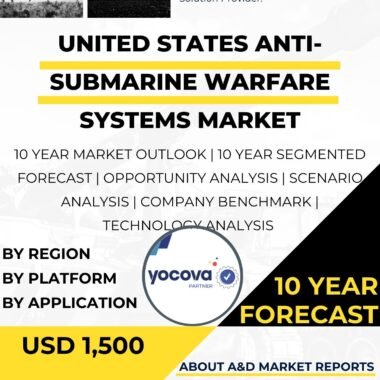Description
Australia Anti-Submarine Warfare Systems Market
The Australia Anti-Submarine Warfare Systems Market is a rapidly evolving sector that strengthens the nation’s maritime defense and protects its territorial waters from submarine threats. ASW systems use advanced technologies to detect, track, and neutralize hostile submarines. As a maritime nation with vast coastlines and core interests in the Indo-Pacific, Australia continues to invest heavily in modern ASW solutions to protect sea lanes, safeguard naval assets, and maintain deterrence.
Market Overview
The Australia Anti-Submarine Warfare Systems Market has gained strong momentum in recent years. Growing submarine activity in the Indo-Pacific has pushed Australia to enhance its ASW capabilities. Securing trade routes, defending maritime borders, and ensuring strategic stability are key factors driving these investments.
Key Market Drivers
Rising Submarine Threats in the Indo-Pacific
The Indo-Pacific region has witnessed a steady expansion of advanced submarine fleets. This trend creates a direct need for Australia to upgrade its ASW technologies to maintain a robust defensive posture.
Naval Fleet Modernization
Australia’s ongoing defense modernization programs include major investments in sonars, torpedoes, maritime patrol aircraft, and underwater surveillance systems. These investments ensure stronger detection and response capabilities.
Focus on Indigenous Defense Production
Government–industry collaboration is helping develop ASW systems tailored to Australian naval requirements. This improves capability, strengthens the domestic defense sector, creates jobs, and supports future technology exports.
Core Technologies in the Australia ASW Systems Market
Sonar Systems
Sonar is the backbone of ASW operations. It enables early detection and continuous tracking of underwater threats. Sonars are deployed on surface ships, submarines, and maritime patrol aircraft.
Anti-Submarine Torpedoes
Precision-guided torpedoes are used to engage and neutralize enemy submarines once detected. These weapons significantly improve the ADF’s ability to respond to underwater threats.
Underwater Surveillance Networks and UUVs
Fixed sensor networks and unmanned underwater vehicles (UUVs) expand surveillance coverage and provide persistent monitoring in high-priority maritime zones.
Role of Alliances and Regional Cooperation
Australia’s ASW strength grows further through partnerships with regional allies. Joint naval exercises, shared intelligence, and interoperable technologies improve collective ASW effectiveness in the Indo-Pacific.
Key Challenges
Rapid Evolution of Submarine Technology
Emerging submarine technologies require continuous research and development to stay ahead of potential adversaries.
Environmental & Noise Pollution Issues
Underwater noise from human and industrial activity interferes with sonar accuracy. Reducing noise and improving sonar performance remains a technical priority.
Interoperability and System Integration
Effective ASW operations depend on seamless integration between sensors, platforms, and command systems. Improving interoperability enhances operational efficiency and mission success.
Future Outlook
The Australia Anti-Submarine Warfare Systems Market will continue to expand as the country prioritizes maritime security and defense readiness. Investments in R&D, new ASW platforms, and advanced underwater technologies will shape the next phase of growth. Strong government-industry collaboration and continued emphasis on regional cooperation will further strengthen ASW capabilities.
Conclusion
The Australia Anti-Submarine Warfare Systems Market is a vital component of the nation’s defense strategy. Advanced ASW solutions help protect territorial waters, secure key maritime routes, and maintain stability in the Indo-Pacific. With ongoing modernization efforts, a strong focus on innovation, and increasing regional collaboration, Australia is well-positioned to enhance its ASW effectiveness and support long-term maritime security goals.




